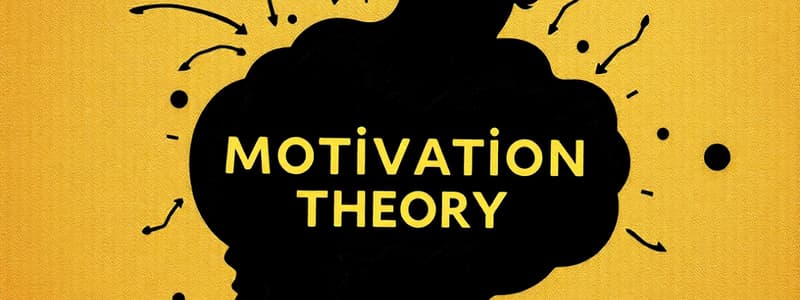Podcast
Questions and Answers
What does motivation fundamentally represent in psychology?
What does motivation fundamentally represent in psychology?
- An internal factor that does not influence behavior (correct)
- The principles of learning and adapting (correct)
- A fixed trait of one’s personality (correct)
- The ability to reason logically (correct)
What is considered a motivator or trigger in behavior?
What is considered a motivator or trigger in behavior?
- A random occurrence
- A pre-existing belief system
- An external acknowledgment
- An internal factor compelling action (correct)
How is motivation described in the context of behavior?
How is motivation described in the context of behavior?
- Static and unchanging
- A complex interplay between individual and environment (correct)
- Limited to learned behaviors only
- A simple reaction to external stimuli
Which of the following factors does motivation NOT encompass?
Which of the following factors does motivation NOT encompass?
What is a key aspect of how hunger functions as a motivator?
What is a key aspect of how hunger functions as a motivator?
What is intrinsic motivation primarily driven by?
What is intrinsic motivation primarily driven by?
Which of the following best exemplifies the importance of motivation in sports?
Which of the following best exemplifies the importance of motivation in sports?
What does extrinsic motivation refer to?
What does extrinsic motivation refer to?
Why do some athletes quit while others persist in their sports activities?
Why do some athletes quit while others persist in their sports activities?
What is a common challenge athletes face that is closely related to motivation?
What is a common challenge athletes face that is closely related to motivation?
What are primary motivations primarily characterized as?
What are primary motivations primarily characterized as?
How do secondary motivations generally differ from primary motivations?
How do secondary motivations generally differ from primary motivations?
What typically happens to psychological or social needs when basic physiological needs become compromised?
What typically happens to psychological or social needs when basic physiological needs become compromised?
What does the process of motivation lead to in an organism?
What does the process of motivation lead to in an organism?
What role do needs play in the formation of motivation?
What role do needs play in the formation of motivation?
Which example illustrates a scenario where psychological needs override physical needs?
Which example illustrates a scenario where psychological needs override physical needs?
What is typically the result when a need is fulfilled?
What is typically the result when a need is fulfilled?
What is indicated by a situation where a person prioritizes their psychological needs over physiological necessities?
What is indicated by a situation where a person prioritizes their psychological needs over physiological necessities?
What encompasses the phenomenon of motivation in individuals?
What encompasses the phenomenon of motivation in individuals?
Which of the following is NOT a type of motivation identified in the content?
Which of the following is NOT a type of motivation identified in the content?
What is a key factor that helps educators manage student behavior?
What is a key factor that helps educators manage student behavior?
Which of the following best describes a 'drive'?
Which of the following best describes a 'drive'?
Which type of need can potentially lead to self-actualization?
Which type of need can potentially lead to self-actualization?
What motivates physical activity in humans?
What motivates physical activity in humans?
How are motives generally characterized?
How are motives generally characterized?
What is an example of an acquired motive?
What is an example of an acquired motive?
Study Notes
Motivation: Driving Force Behind Behavior
- Motivation plays a crucial role in understanding human behavior, influencing learning, adapting to the environment, and achieving mental well-being.
- Motivation is an internal factor that compels individuals to perform specific actions and persist in them until the need is fulfilled.
- It encompasses conscious and unconscious, innate and acquired, internal and external factors, all contributing to initiating, directing, and sustaining behavior towards a goal.
- Needs arise from a lack of essential elements, leading to a desire to restore balance; this desire is called motivation.
- Motivation can be influenced by various factors, including physical, psychological, and social needs, making it crucial for educators and coaches to understand these dynamics.
Types of Motivation
- Motivation can be broadly categorized into two types:
- Primary Motivations: Innate, inherited, physiological, and biological in nature. Examples include hunger, thirst, and the need for sleep.
- Secondary Motivations: Learned, psychological, and social motivators, such as a desire for achievement, affiliation, or power.
Motivation in Sports
- Understanding motivation is essential in sports psychology to understand why some athletes succeed while others fail.
- Motivation is a vital element in driving athletes towards peak performance, as it governs their dedication and effort levels.
Intrinsic vs. Extrinsic Motivation
- Intrinsic Motivation is an internal drive within the athlete stemming from the joy and satisfaction derived from the activity itself.
- Athletes intrinsically motivated find pleasure in training and competition, especially when it is challenging or requires courage.
- Extrinsic Motivation on the other hand, stems from external factors like rewards, praise, recognition, or avoidance of punishment.
Studying That Suits You
Use AI to generate personalized quizzes and flashcards to suit your learning preferences.
Description
This quiz explores the crucial role of motivation in human behavior, examining its influence on learning and mental well-being. Discover the distinctions between intrinsic and extrinsic motivations and how various factors impact our drive towards goals. Ideal for students and educators alike.



